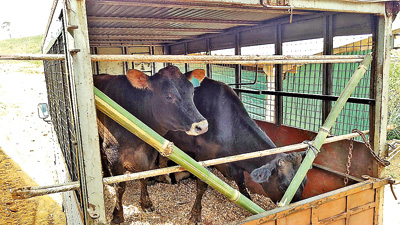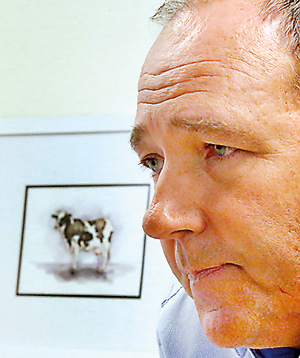News
Wellard urges changes to farm selection criteria as plight of Lankan dairy farmers hits the headlines in Australia

Cows being delivered to farmer Amal Suriyage’s Lammermoor estate in the Nuwara Eliya district in early 2018
The agony of a milky dream which turned sour for many of the 68 Sri Lankan farmers who were part of a government project to import high-yielding pregnant cows from New Zealand and Australia has caused waves in Australia.
Wellard Rural Exports Pty Ltd., the agent and transporter of the dairy cows, headquartered in Fremantle, Australia, on Thursday issued a strong statement that efforts to resolve the current issue have been ongoing for some time and are continuing. Wellard is in negotiations with the Government of Sri Lanka to make changes to the programme to prevent a reoccurrence of these issues for any future shipments.
“No cattle have been shipped since November 2017 and no more cattle will be shipped until changes to the farm selection criteria have been agreed on, which is unlikely to occur this year,” stated Wellard, while the plight of the Sri Lankan farmers whose dreams have turned into nightmares hit the headlines Down Under.
On February 24, the Sunday Times published a full-page detailed investigation on the imported dairy cow crisis headlined ‘Milky dreams turn sour’ (http://www.sundaytimes.lk/190224/news/milky-dream-turns-sour-farmers-337867.html).
Point-by-point, the Sunday Times turned the spotlight on the grievances of the farmers including how many farmers have been forced to close their farms; how many cows have died; the “unfair” prices paid by the farmers for the cows; quarantine procedures not being followed; how some cows were not pregnant and how others had aborted on the way to Sri Lanka; the diseases the cows were afflicted with; the high cost of feed; the promised milk production not becoming a reality; the issues with the price being paid for milk; and the lack of technical support.
The Australian media, meanwhile, took up the issue, with ‘Australian cattle exported to Sri Lanka dying……’ being the lead story on the website of the Australian Broadcasting Corporation (ABC) on Thursday, while ‘The Land’ dubbed in Australia as “the really big rural paper read by every farmer” also turned its focus on this story with ‘Sri Lankan dairy farmers cry foul over dud dairy cows’.
When the cow-imports were raised in Parliament in March Rural Economy Minister P. Harrison had, according to media reports, outlined the colossal waste of public funds that had been allowed under the guise of import substitution under the previous government.
The Sunday Times, meanwhile, is still awaiting a response to the second set of questions sent by email on February 20 to the Rural Economy Ministry’s Project Director for the dairy cow imports, Dr. Sagarika Sumanasekara. Even though she initially responded that she would answer those queries by March 13, there has been absolute silence. Messages and calls to her mobile, the last being on Friday, were unanswered.
Dr. Sumanasekara’s replies to the first set of questions were published by the Sunday Times on February 24.
When the Sunday Times called a Deputy Director of the ministry’s Livestock Development Section, Dr. Niroshan Gamage on Friday in the light of the Australian reaction, he declined to comment. Dr. Gamage is involved in the project and was part of the team which selected the cows in Australia before importation to Sri Lanka.
As an outcry arose in Australia, Wellard issued one statement on March 18 in which it stated that Sri Lanka is a developing country and the dairy export programme has successfully reduced Sri Lanka’s reliance on imported, powdered milk; fostered the growth of the Sri Lankan dairy industry and its support services; and upgraded the Sri Lankan dairy industry’s herd management skills.
A handful of the 68 farmers selected by the Sri Lankan Government to receive some of the 5,000 cattle shipped to date did however fail to follow the prescribed herd management advice processes, which has caused some animal welfare issues on those farms. As a result, the farmer selection criteria will change, it said.
Wellard issued another statement on April 4 that wished to confirm six points with respect to its dairy heifer programme supplying cattle to the Government of Sri Lanka. The points were:
- There was a successful pilot programme in Sri Lanka in 2013 which gave all parties the confidence that the main programme could be run successfully.
- Wellard alerted the general public on 18 March 2018 that it was experiencing some challenges in Sri Lanka (see press release: http://wellard.com.au/wellard-to-make-changes-to-sri-lanka-dairy-program/). This was despite the benefits that the programme was achieving and the provision of technical support by Wellard, which was supposed to end six months after the heifers were delivered to the Federal Government of Sri Lanka but continues to this day.
- Efforts to resolve the current issue have been ongoing for some time and are continuing
- Wellard is in negotiations with the Government of Sri Lanka to make changes to the program to prevent a reoccurrence of these issues for any future shipments
- No cattle have been shipped since November 2017 and no more cattle will be shipped until changes to the farm selection criteria have been agreed, which is unlikely to occur this year
- The animals provided to Sri Lanka were healthy and free of disease. Relevant health certificates, provided by the Government veterinarians from Sri Lanka and Australia before the heifers were exported, can be viewed by clicking on http://www.wellard.com.au/wp-content/uploads/2019/04/Health-Certificate-Swagman-101-Portland.pdf
Some of the issues

Wellard’s Johann Wasserman
When the Sunday Times launched its investigation last year into the imported dairy cow fiasco, many attempts to contact Foresight Engineering Pvt Ltd’s Project Engineer P. Kumarage failed.
Foresight which calls itself “a solutions provider in development, technical cutting-edge technology” is part of the Access Group of Companies.
It is the local agent of Wellard Rural Exports Pty Ltd., which is the agent and transporter of the imported dairy cows.
Even though Mr. Kumarage arranged to meet us for an interview late last year, when we arrived there, he was not in his office at the Access Towers in Colombo 2 and also not contactable on his mobile.
Thereafter, Wellard’s Technical Dairy Advisor & International Project Manager, Johann Wasserman agreed to speak to us.
Mr. Wasserman said that before 2016, a project of the National Livestock Development Board (NLDB) was also implemented by Wellard, under an agreement between Sri Lanka and Australia. It was after the success of the NLDB project that the Sri Lankan government decided to support small-scale private farmers with such imports.
“The government selected those who were interested in being small-scale farmers and their farms were inspected by the Department of Animal Production and Health. After selections, the farmers applied for a government loan to set up the infrastructure and also buy the cows,” he said.
Explaining the different roles played by them, Mr. Wasserman said Wellard was the project supplier from Australia, while Foresight had a team of 70 personnel which included technical support staff, veterinary surgeons, livestock officers and engineers. Foresight has regional office staff in Kandy, Matale, Hatton, Kurunegala and Badulla.
According to him Wellard supported the farms for six months and the government was supposed to continue thereafter. “It took a very long time for the project to even begin. We had to bring a certain number of cattle so we needed a certain number of farmers. There were a lot of technical difficulties.”
Pointing out that only about 30-40% of farmers had a previous knowledge of dairy farming, Mr. Wasserman said that training programmes were held and handbooks distributed among the farmers. The training sessions were conducted for the farmers by experienced farmers and ministry and livestock officers. There were two training sessions per region.
When the farms started operating, there was a checklist that someone from the farm signed off on. Wellard got reports from the farms on a daily basis. There were veterinarians on each farm for six months. Wellard officials also visited the farms, he said.
He stressed that farmers had been told that they would get no income in the first 3-4 months. The farmers had to be responsible and take ownership of their cows. The farmers were asked to make calf boxes for the calves but a lot of farmers had not done it to the necessary specifications.
Some of the problems, according to Mr. Wasserman were:
- Feed – The cows had to be fed well, with the feed being of the right quality and consistency, to produce the promised milk quantity. Farmers were advised to grow their own crops as well as have their own silage to ensure a steady supply of feed. The cows have to be fed 50% feed and 50% concentrate which is a combination of maize, corn, wheat etc.
Only 50-60% of the farmers fed their cows properly, while the others switched to cheaper, low-quality feed later on, he alleged, adding that 60% of the expenditure at the farms would be for the feed.
- Payment from Milco for the milk — There was an issue of payment from Milco for the milk. If the payments for the milk to the farmers do not come on time, it would affect the feeding of the cows which would, in turn, lead to the quality of the milk dropping.
- Grace period — A six-month grace period is not adequate for the farmers to pay back their loans and some scheme needs to be worked out.
- Need for farmers to grow their crops — There were a lot of variables in the project. One of them was that some farmers grew their own feed so their expenditure was not as much.
Meanwhile, there were different brands trying to sell their products to the farmers at a cheaper rate which led to them giving low-quality feed to the cows.
The cost of concentrate at the beginning of the project was Rs. 48 but had risen to Rs. 62 later and even though this cost increased, the milk price did not change.

